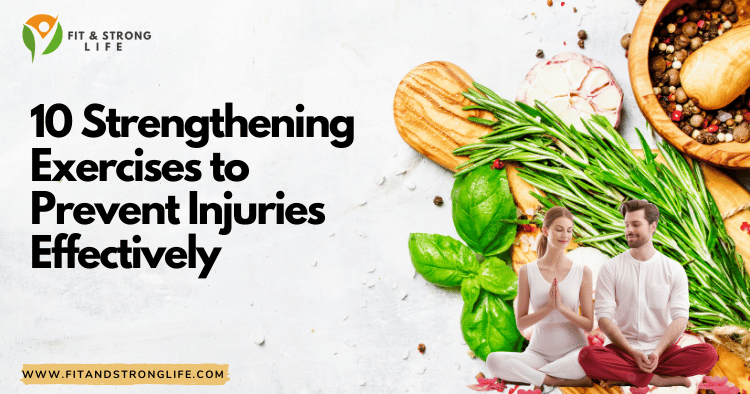Table of Contents
- Introduction
- Importance of Strengthening Exercises
- Exercise 1: Squats
- Exercise 2: Lunges
- Exercise 3: Plank
- Exercise 4: Push-Ups
- Exercise 5: Deadlifts
- Exercise 6: Glute Bridges
- Exercise 7: Rows
- Exercise 8: Side Leg Raises
- Exercise 9: Core Twists
- Exercise 10: Wall Sits
- FAQs
- Conclusion
Introduction
In the quest for a healthier lifestyle, injury prevention is often overlooked. However, incorporating targeted strengthening exercises into your routine can significantly reduce the risk of injuries. This article will explore ten effective exercises that not only build strength but also enhance stability and flexibility, helping you stay active and pain-free.
Importance of Strengthening Exercises
Strengthening exercises are vital for maintaining muscle balance, improving joint stability, and supporting overall physical performance. They help improve posture, reduce muscle imbalances, and enhance your ability to perform daily activities. According to the American Council on Exercise, regular strength training can reduce the risk of injury by up to 40%, especially when combined with other forms of fitness like cardiovascular workouts and stretching. For a comprehensive look at nutrition to support your fitness journey, check out the Essential Guide to Macronutrients for Optimal Fitness.
“Strengthening exercises are not just for athletes; they are essential for everyone looking to maintain a healthy lifestyle.”
Exercise 1: Squats
How to Do It:
- Stand with your feet shoulder-width apart.
- Lower your body by bending your knees and pushing your hips back, as if sitting in a chair.
- Keep your chest up and your back straight.
- Lower until your thighs are parallel to the ground, then return to standing.
Benefits: Squats strengthen the quadriceps, hamstrings, glutes, and core, which are essential for maintaining balance and stability.
“Think of squats as the foundation for all lower body movements—strong legs lead to a strong body!”
Exercise 2: Lunges
How to Do It:
- Stand tall, then step forward with one leg, lowering your hips until both knees are bent at about a 90-degree angle.
- Ensure your front knee is directly above your ankle.
- Push back to the starting position and repeat on the other side.
Benefits: Lunges work multiple muscle groups, including the legs and core, and help improve balance and coordination.
“Lunges are like a dance move—practice makes perfect, and they’ll help you glide through everyday activities!”
Exercise 3: Plank
How to Do It:
- Start in a push-up position with your arms straight.
- Keep your body in a straight line from head to heels.
- Hold this position for 20–60 seconds, focusing on tightening your core.
Benefits: Planks strengthen the entire core, which is crucial for stabilizing the spine and preventing injuries.
“A strong core is your best defense against injury—planks are your secret weapon!”
Exercise 4: Push-Ups
How to Do It:
- Start in a plank position with your hands slightly wider than shoulder-width apart.
- Lower your body until your chest nearly touches the floor.
- Push back up to the starting position.
Benefits: Push-ups target the chest, shoulders, and triceps while also engaging the core, making them a great full-body exercise.
“Push-ups can be done anywhere—no gym required! Just you and your determination.”
Exercise 5: Deadlifts
How to Do It:
- Stand with your feet hip-width apart, holding a barbell or dumbbells in front of you.
- Keep your back straight and lower the weights by bending at your hips and knees.
- Drive through your heels to return to standing.
Benefits: Deadlifts strengthen the posterior chain, including the back and hamstrings, which is essential for preventing lower back injuries.
“Deadlifts are not just for the gym—they teach you how to lift heavy things in life safely!”
Exercise 6: Glute Bridges
How to Do It:
- Lie on your back with your knees bent and feet flat on the floor.
- Lift your hips off the ground, squeezing your glutes at the top.
- Hold for a moment, then lower back down.
Benefits: Glute bridges target the glutes and lower back, contributing to better pelvic stability and reducing the risk of injuries.
“Strong glutes are the key to a strong body—don’t neglect them!”
Exercise 7: Rows
How to Do It:
- Stand with your feet hip-width apart, holding a dumbbell in each hand.
- Bend slightly at the hips and knees, keeping your back straight.
- Pull the weights towards your torso, squeezing your shoulder blades together.
Benefits: Rows strengthen the upper back and shoulders, which helps improve posture and prevent shoulder injuries.
“Rows are your ticket to a strong back—better posture and less pain!”
Exercise 8: Side Leg Raises
How to Do It:
- Lie on one side with your legs stacked.
- Lift the top leg straight up, keeping it aligned with your body.
- Lower it back down without touching the bottom leg.
Benefits: Side leg raises strengthen the hip abductors, which are key for stabilizing the pelvis during movement.
“Don’t forget about your hips—they play a crucial role in stability and preventing injuries.”
Exercise 9: Core Twists
How to Do It:
- Sit on the ground with your knees bent and feet flat.
- Lean back slightly and twist your torso to one side, then the other.
- For added intensity, hold a weight or medicine ball.
Benefits: Core twists enhance rotational strength and stability, which is vital for many sports and daily activities.
“Engaging your core in different ways can make all the difference in your performance and injury prevention.”
Exercise 10: Wall Sits
How to Do It:
- Stand with your back against a wall and slide down until your knees are at a 90-degree angle.
- Hold this position for 30–60 seconds.
Benefits: Wall sits target the quadriceps and improve endurance, which is beneficial for various physical activities.
“Wall sits are a test of willpower—can you hold it long enough to feel the burn?”
FAQs
Q: How often should I perform these exercises?
A: Aim for at least two to three sessions per week, allowing for recovery between workouts.
Q: Can I do these exercises at home?
A: Absolutely! Most of these exercises require little to no equipment and can easily be done at home.
Q: How do I know if I’m doing these exercises correctly?
A: Consider consulting a fitness professional or use online tutorials to ensure proper form and technique.
Q: What if I have a pre-existing injury?
A: Always consult with a healthcare provider or physical therapist before beginning any new exercise program.
Conclusion
Incorporating these ten strengthening exercises into your fitness routine can significantly reduce the risk of injuries and improve your overall physical health. Remember, consistency is key! Start slowly, focus on your form, and gradually increase the intensity as your strength improves. For more information on nutrition to support your fitness journey, explore Top 10 Essential Supplements for Optimal Fitness 2024.
So, gear up, get moving, and let’s strengthen our way to a healthier, injury-free life!




